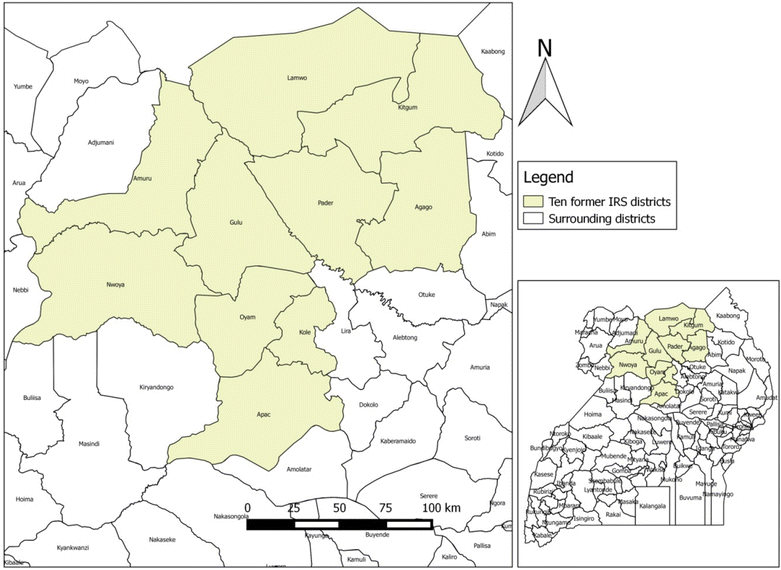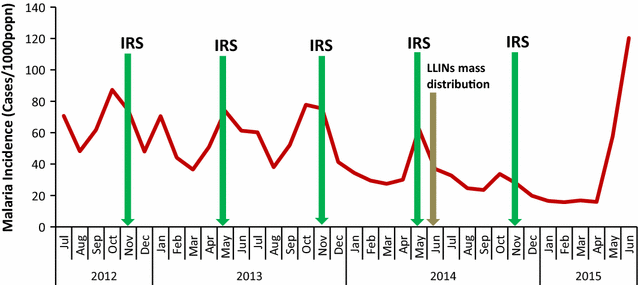Malaria incidence among children less than 5 years during and after cessation of indoor residual spraying in Northern Uganda
- PMID: 28784119
- PMCID: PMC5547524
- DOI: 10.1186/s12936-017-1966-x
Malaria incidence among children less than 5 years during and after cessation of indoor residual spraying in Northern Uganda
Abstract
Background: In June 2015, a malaria epidemic was confirmed in ten districts of Northern Uganda; after cessation of indoor residual spraying (IRS). Epidemic was defined as an increase in incidence per month beyond one standard deviation above mean incidence of previous 5 years. Trends in malaria incidence among children-under-5-years were analysed so as to describe the extent of change in incidence prior to and after cessation of IRS.
Methods: Secondary data on out-patient malaria case numbers for children-under-5-years July 2012 to June 2015 was electronically extracted from the district health management information software2 (DHIS2) for ten districts that had IRS and ten control districts that didn't have IRS. Data was adjusted by reporting rates, cleaned by smoothing and interpolation and incidence of malaria per 1000 population derived. Population data obtained from 2002 and 2014 census reports. Data on interventions obtained from malaria programme reports, rainfall data obtained from Uganda National Meteorological Authority. Three groups of districts were created; two based on when IRS ended, the third not having IRS. Line graphs were plotted showing malaria incidence vis-à-vis implementation of IRS, mass net distribution and rainfall. Changes in incidence after withdrawal of IRS were obtained using incidence rate ratios (IRR). IRR was calculated as incidence for each month after the last IRS divided by incidence of the IRS month. Poisson regression was used to test statistical significance.
Results: Incidence of malaria declined between spray activities in districts that had IRS. Decline in IRR for 4 months after last IRS month was greater in the sprayed than control districts. On the seventh month following cessation of IRS, incidence in sprayed districts rose above that of the last spray month [1.74: 95% CI (1.40-2.15); and 1.26: 95% CI (1.05-1.51)]. Rise in IRR continued from 1.26 to 2.62 (95% CI 2.21-3.12) in June 2015 for districts that ended IRS in April 2014. Peak in rainfall occurred in May 2015.
Conclusion: There was sustained control of malaria incidence during IRS implementation. Following withdrawal and peak in rainfall, incidence rose to epidemic proportions. This suggests a plausible link between the malaria epidemic, peak in rainfall and cessation of IRS.
Keywords: Indoor residual spraying; Malaria epidemic; Malaria incidence.
Figures




References
-
- WHO. World Malaria Report 2015. Geneva: World Health Organization; 2015. http://apps.who.int. Accessed 10 May 2016.
-
- Ministry of Health. The Uganda malaria reduction strategic plan 2014–2020. Kampala; 2014. http://health.go.ug/content/uganda-malaria-reduction-strategic-plan-2014.... Accessed 15 Jan 2016.
-
- WHO. Indoor residual spraying. An operational manual for indoor residual spraying (IRS) for malaria transmission control and elimination. 2nd Ed. Geneva: World Health Organization; 2015. http://www.who.int/malaria/publications/atoz/9789241508940/en/. Accessed 10 Feb 2016.
-
- WHO. World malaria report 2012. Geneva: World Health Organization; 2012. http://www.who.int/malaria/publications/world_malaria_report_2012/wmr201.... Accessed 14 July 2016.
Publication types
MeSH terms
Substances
LinkOut - more resources
Full Text Sources
Other Literature Sources
Medical
Miscellaneous

